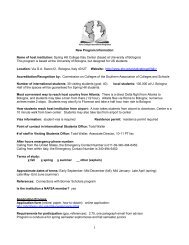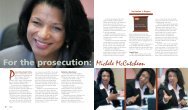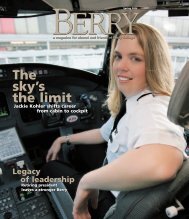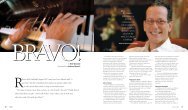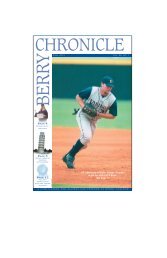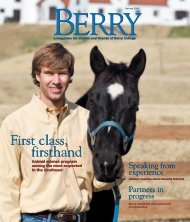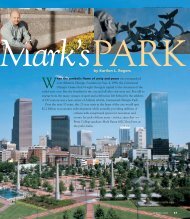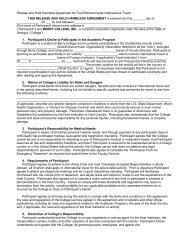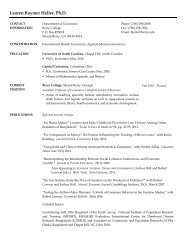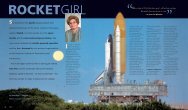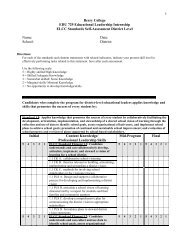92 Chronicle Fall02 for Web - Berry College
92 Chronicle Fall02 for Web - Berry College
92 Chronicle Fall02 for Web - Berry College
- No tags were found...
Create successful ePaper yourself
Turn your PDF publications into a flip-book with our unique Google optimized e-Paper software.
MESSAGEPRESIDENT’SAGRICULTURE IN OUR ROOTSAND IN OUR FUTUREAgriculture has been a part of <strong>Berry</strong>since our earliest days. From thestart, pragmatism and theeducational needs of our students havedetermined its role. Agriculture was sosignificant at <strong>Berry</strong> in our early yearsthat Martha <strong>Berry</strong> will soon be inductedin the Georgia Agricultural Hall of Fame.Nearly 50 years after <strong>Berry</strong> students lastate what was grown on college farms,one could wonder if agriculture willthrive at <strong>Berry</strong> in the 21st century.The history of agricultural studies at<strong>Berry</strong> has been a history of continuingchange. <strong>Berry</strong>’s fifth president, Dr. JohnBertand, a <strong>for</strong>mer agriculture schooldean, was committed to a strong,balanced undergraduate college program.He trans<strong>for</strong>med <strong>Berry</strong> into an accreditedliberal arts college with professionalprograms in business and teacherpreparation, one in which the agriculturalsciences would eventually become a partof the natural science curriculum. UnderDr. Bertrand’s leadership, the collegemoved from farming and production toclassroom and laboratory studies inagriculture.As early as 1915, <strong>Berry</strong> had a modelfarm program in which exemplaryfarming practices were carried out. Amajor in agriculture dates to 1930 andwas offered until 1968. <strong>College</strong> catalogsfrom the early 1950s refer to a 50-acrevegetable garden and a 35-acre orchard,as well as beef, dairy, hog and poultryoperations. The garden, orchard, hog andpoultry operations ceased after Dr.Bertrand became president.<strong>Berry</strong> introduced two-year certificateprograms in animal, horticultural anddairy technology in the 1960s,converting them a decade later to twoyearassociate of science degreeprograms. The associate of sciencedegrees were dropped in 1989. Thebachelor of science degree with a majorin animal science was begun in 1975,and ornamental horticulture became amajor in 1989. By 1993, that major hadbeen changed simply to “horticulture.”The study of agriculture at <strong>Berry</strong> hasthus evolved as the educational needs ofour students — and the world in whichour students live — have evolved.Among recent changes in our animalscience program was our decision in2001 to devote the dairy herd toteaching and research rather than milkproduction. For a long period, the large,nationally recognized <strong>Berry</strong> dairy herdproduced milk that was sold. In recentyears, our faculty could not support theeducational value of producing milkbeyond our students’ need to studyanimal science. There<strong>for</strong>e we reduced thedairy herd to 20 cows and used theproceeds of the sale of stock to equip acontemporary teaching and researchdairy at the Rollins Ruminant ResearchCenter. [Read more about the new dairyand the Normandy restoration on pages4 and 5.]<strong>Berry</strong> has just appointed a specialist inplant science to our faculty who has heldappointments in a school of agricultureand an agricultural extension service.Her arrival represents a shift from aconcentration upon horticulture toward afocus upon plant science as well asteaching and research in agriculture.<strong>Berry</strong> students who wish to developexpertise in horticulture can gainvaluable work experience on the college“As long as theenvironment mattersto us — that is,air quality, wise uses ofwater and land resources,waste management, aswell as food production —then scientific study ofagriculture will beimportant at <strong>Berry</strong>.”—DR. SCOTT COLLEYcampus, at Oak Hill and in ourhorticultural greenhouses, as do about80 students annually. The campus, OakHill and the college greenhousesrepresent wonderful learninglaboratories.The college still maintains a largeAngus herd that produces about 120calves annually. The cows exist <strong>for</strong> theacademic program, and not vice versa.Students learn genetics, anatomy andphysiology, and beef management fromacademic study as well as first-handexperience working with the cattle. Wehave a breeding program in our equineprogram that offers <strong>Berry</strong> studentsfurther laboratory opportunities. We alsomaintain 24 ewes, as Department ChairAllen Scott says, “To teach kids frominside the I-285 perimeter how to handleanimals.” Our students start small andwork up from there.Each year, four or five <strong>Berry</strong> studentsare accepted to veterinary medicineprograms. They tend to rise to the top oftheir classes because of their excellentclassroom education and frequentexperience with animals. Students at<strong>Berry</strong> spend more time with animals thando many students in graduate animalscience programs. About half of ouranimal science graduates eventually endup in graduate or professional study. Formany years, animal science has beenone of the most popular majors at <strong>Berry</strong>.We are confident that the new major thatcombines animal and plant science willbe an even more popular choice <strong>for</strong> ourstudents.The <strong>Berry</strong> agriculture faculty is madeup of five professors, three of whomhave won campus awards <strong>for</strong> excellentteaching. The professors are assisted byseven staff members who manage dairyand beef operations, the equestriancenter and horticultural greenhouses.These staff members serve as mentorsand laboratory instructors to <strong>Berry</strong>students who learn from first-handexperience in our various agriculturaloperations. We anticipate makinganother agriculture faculty appointmentin the future to strengthen an alreadyfine academic program.<strong>Berry</strong> is unusual in possessing a28,000-acre environmental scienceslaboratory. We have a fine new sciencebuilding and a strong natural scienceprogram that is complemented by ourstrong program in agriculture. As long asthe environment matters to us — that is,air quality, wise uses of water and landresources, waste management, as well asfood production — then scientific studyof agriculture will be important at <strong>Berry</strong>.Indeed, agricultural studies at <strong>Berry</strong> havenever been stronger, and prospects <strong>for</strong>our second century look bright. ■— DR. SCOTT COLLEYCHRONICLEBERRYFALL 2002 • VOL. 89, NO. 1EDITORDawn TolbertCONTRIBUTORSKarilon RogersDebbie RasureDESIGN & PRODUCTIONShannon Biggers (81C)Stacy CatesPHOTOGRAPHYPaul O’MaraAlan StoreyThe BERRY CHRONICLE is publishedby the <strong>Berry</strong> <strong>College</strong> Office ofPublic Relations, P.O. Box 490279,Mount <strong>Berry</strong>, GA 30149-0279.Please send address changes toAlumni Office, P.O. Box 495018,Mount <strong>Berry</strong>, GA 30149-5018.ALAN STOREY3



